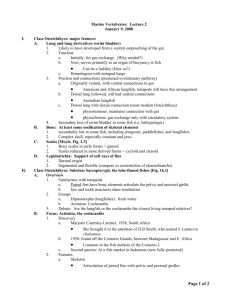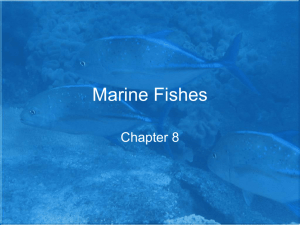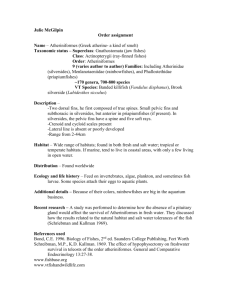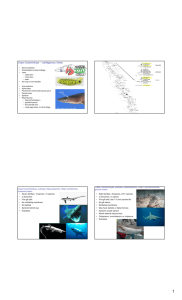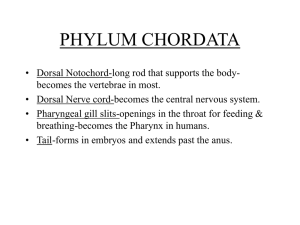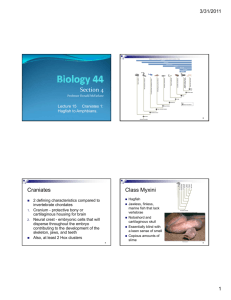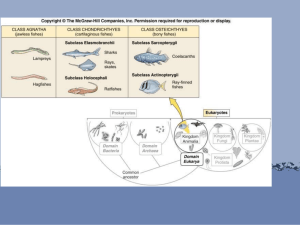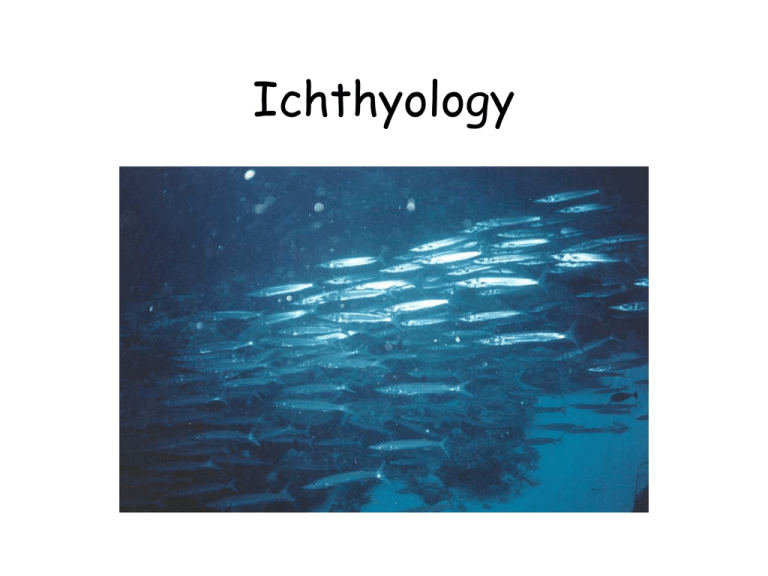
Ichthyology
“jawed fishes”
• Class Chondrichthyes- cartilaginous
• Subclass Elasmobranchii- sharks, rays, and
skates
• Subclass Holocephali- chimeras & ratfishes
• Class Osteichthyes- bony fishes
• Subclass Dipnoi- lung fishes
• Subclass Crossopterygii- coelocanth
• Subclass Actinopterygii- modern bony fishes
Class Chondrichthyes:
(Cartilaginous Fishes)
•
•
•
•
•
•
general diagnostic characters:
reduced dermal armor
cartilaginous endoskeleton & girdles
tricuspid teeth
gill slits
fins: two dorsal, no anal, stiff
pectorals, flexible pelvic
• heterocercal tail
Sharks
Sting Ray
Manta Ray
Chimera or Ratfish
1st Elasmobranch Radiation
diagnostic characters:
1. shark-like appearance
2.
terminal mouth; amphistylic jaw
suspension
3.
unique tooth replacement
4.
claspers
Claspers
nd
2
Elasmobranch Radiation
diagnostic characters:
1. heterodont dentition
2. unique pectoral & pelvic fin
arrangements
3. heterocercal tail
Extant Forms
• Elasmobranchii [sharks (360 species)
, skates & rays (456 species); appear
in the Jurassic
diagnostic characters of sharks
1.
hyostylic jaw suspension & rostrum
2.
cranial kinesis- allows consumption of large food
items
3.
pectoral girdle fused ventrally
4.
placoid scales
5.
lack gas bladder; liver provides buoyancy (~ 25%
of body mass).
Hyostylic Jaw Suspension
sensory systems
1.
lateral line system (mechanoreceptors)
2.
ampullae of Lorenzini (detects electrical
impulses)
3.
acute chemosensory
4.
tapetum lucidum
5.
internal fertilization and large female
investment; oviparity, ovoviviparity, & viviparity
Ampullae of Lorenzini
Placoid Scales
Placoid Scales
Shark Egg Case
diagnostic characters of skates & rays
1.
hard teeth with flat crowned plates; mostly
adapted for feeding on benthic invertebrates
2.
swimming via undulations of pectoral fins
3.
stingrays (family Dasyatidae) modified placoid
scales form a sting at the base of the tail
4.
manta rays (family Mobulidae) plankton
feeders
Cartilaginous Skeleton
Shark Anatomy Link
Click Here
Class Osteichthyes: “bony fishes”
• most abundant and diverse
vertebrates >21,000 species
• bony scales (enlarged in the head
region)
• operculum covering the gills
• stream-lined; laterally compressed
• ossified endoskeleton; secondarily
lost in some species
Operculum
Dipnoans
1. subclass Dipnoi- "double breathers";
lungfishes
2. upper jaw fused to the brain case; large,
crushing tooth plates
3. two dorsal fins
4. paired fins
Crossopterygians
• dominant fresh water predators
during the Devonian period
• rhipidistians (ancestor to amphibians)
& coelacanth; Latimeria (extant)
important structural characteristics:
• lobed fins with elements connecting to
pectoral & pelvic girdles
• autostylic jaw suspension- jointed
braincase (jaw connects directly to the
brain case)
• labyrinth tooth- complex folding of the
enamel
Coelocanth (Latimeria)
Actinopterygians (ray-finned fishes)
• most modern bony fishes; subclass Actinopterygii
• important structural characteristics:
• ganoid scales
• distinctive pectoral & pelvic girdles
• fins attach to the body via flexible fin rays
instead of a fleshy lobe
• branchiostegal rays
• no internal nares
Branchiostegal Rays
Ganoid Scales
Ctenoid Scales
Cycloid Scales
“bony fish”
Paddlefish (Polydon)
Sturgeon
Fish Diversity
Smallmouth Bass
Green Sunfish
Catfish
Oklahoma Non-game Fish


